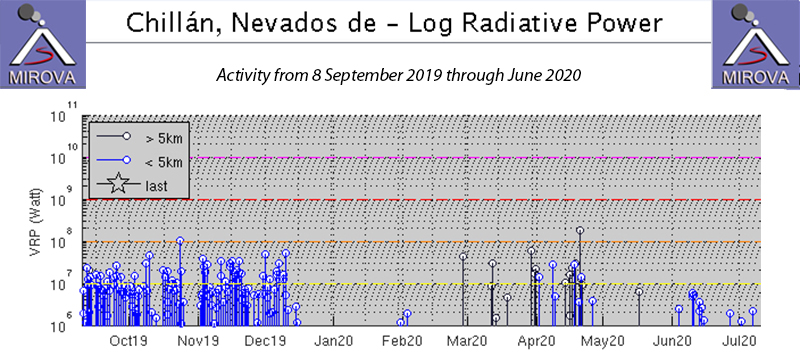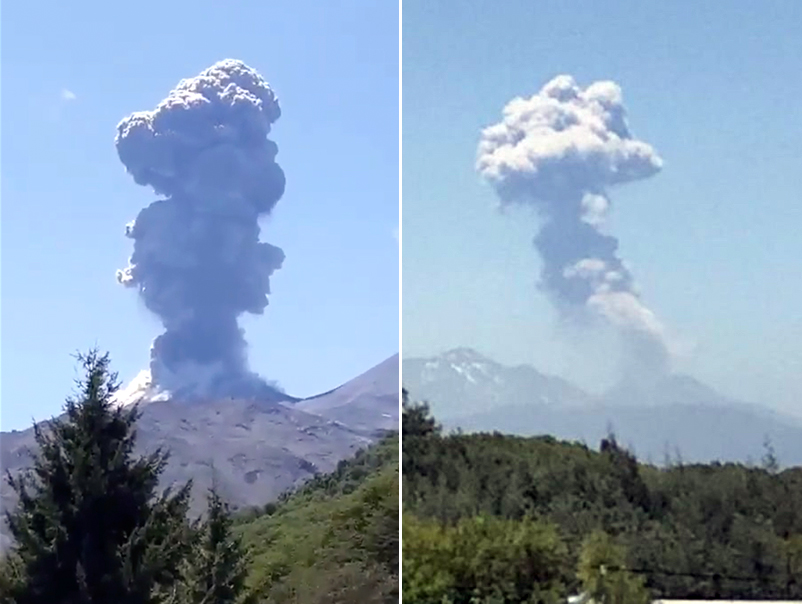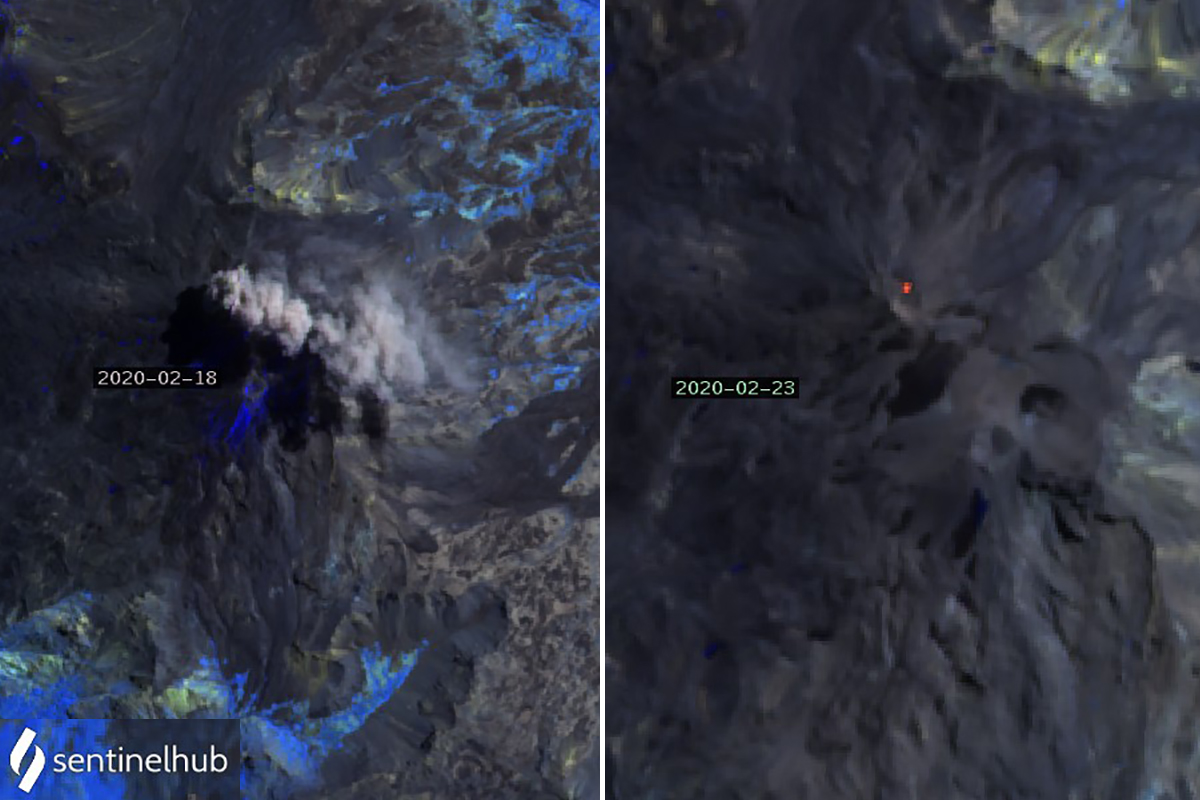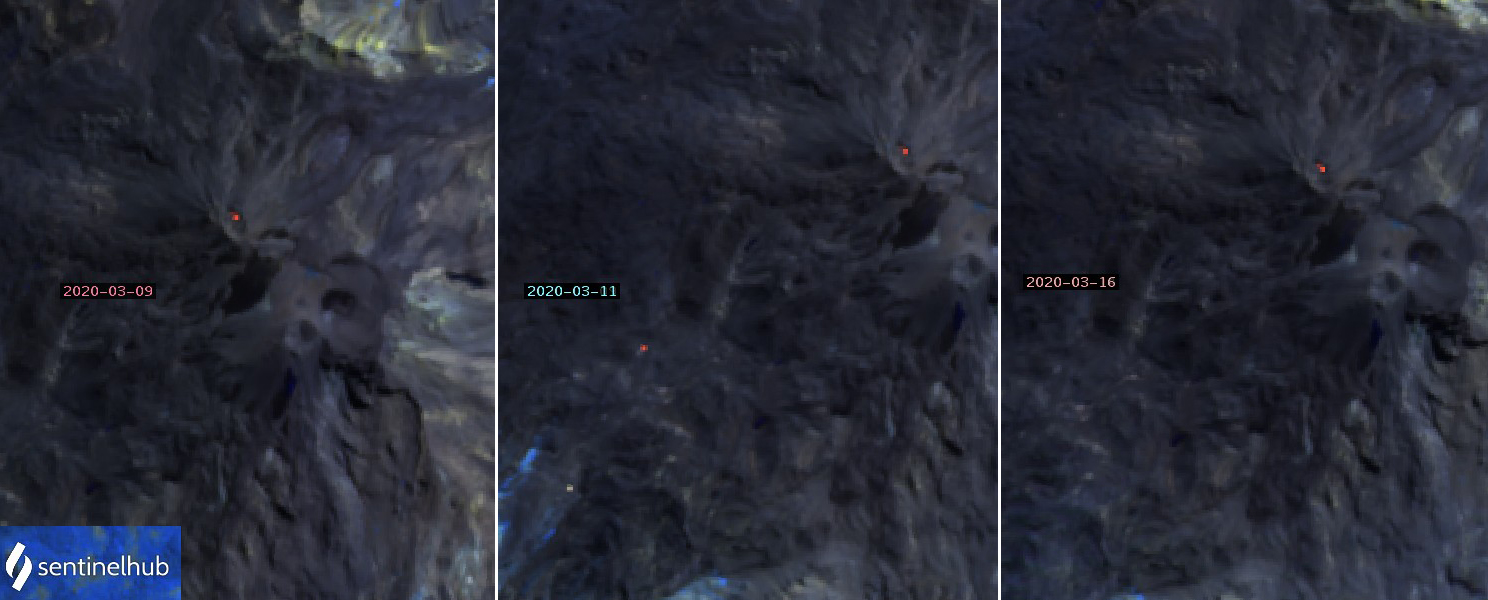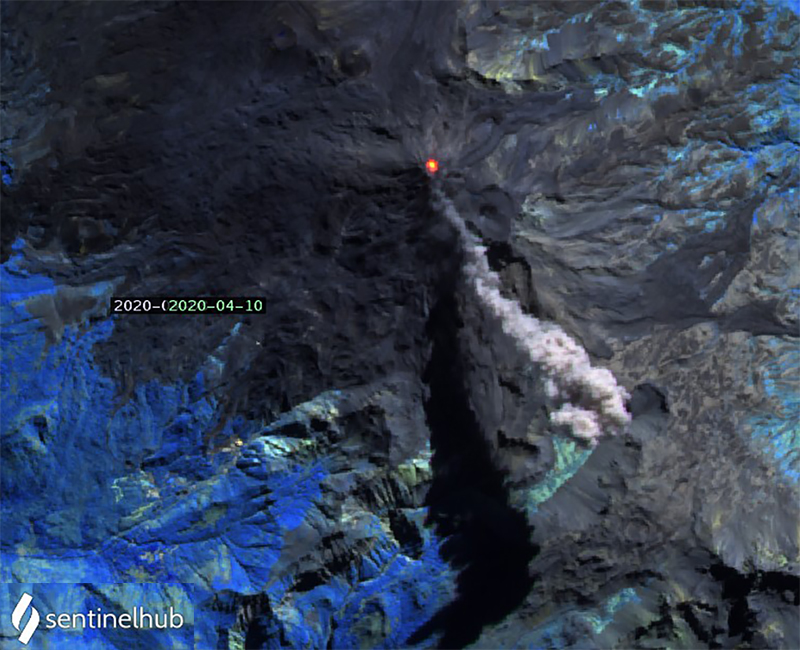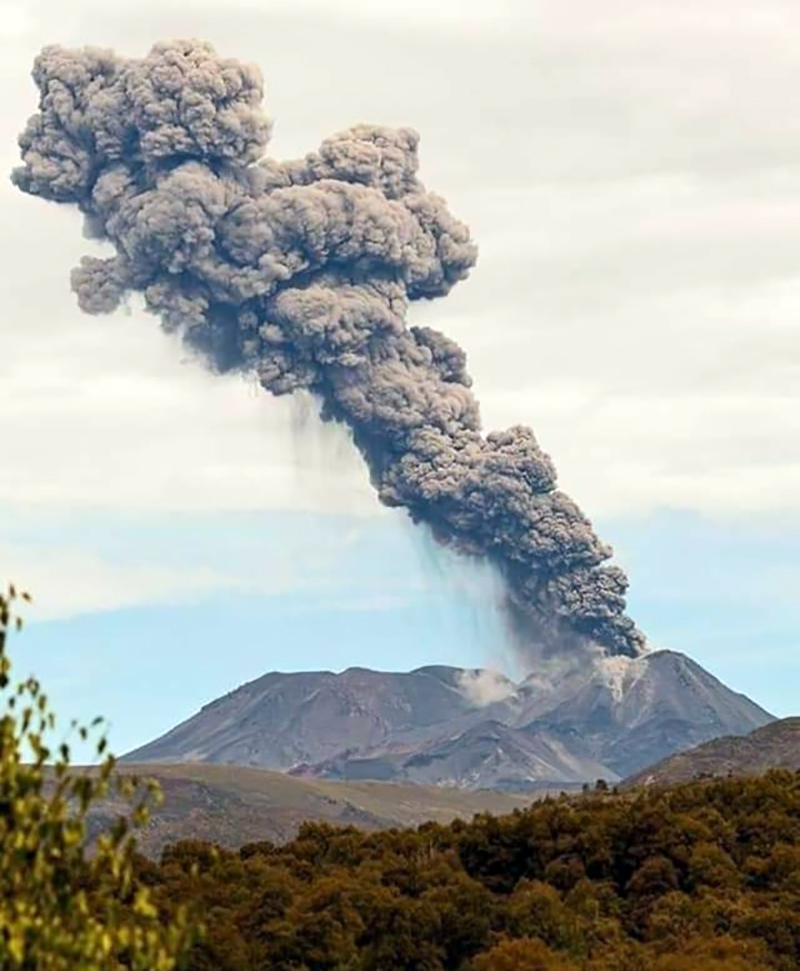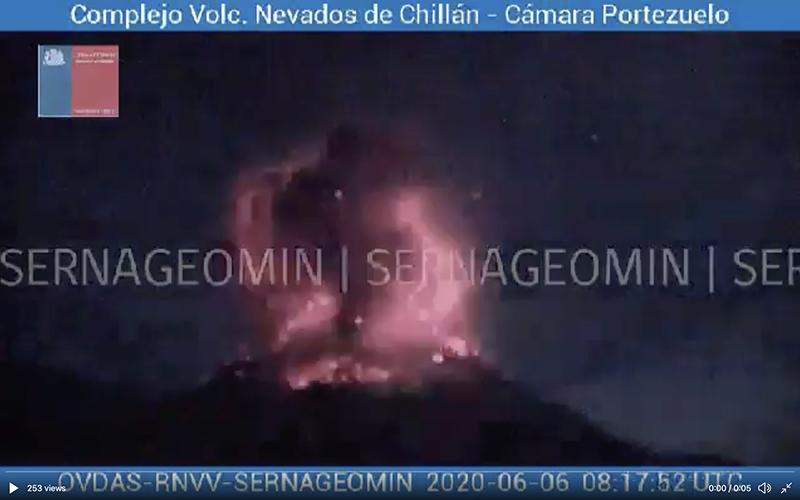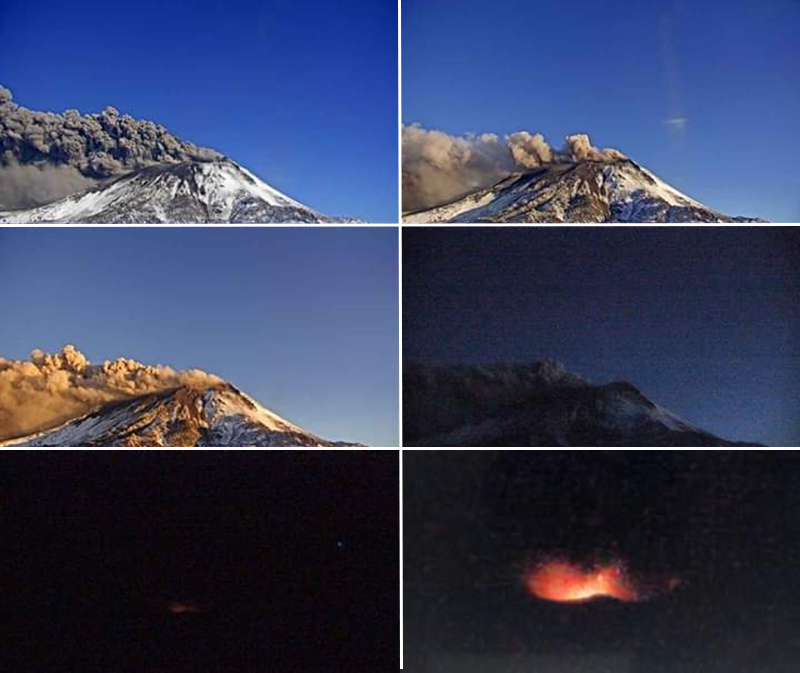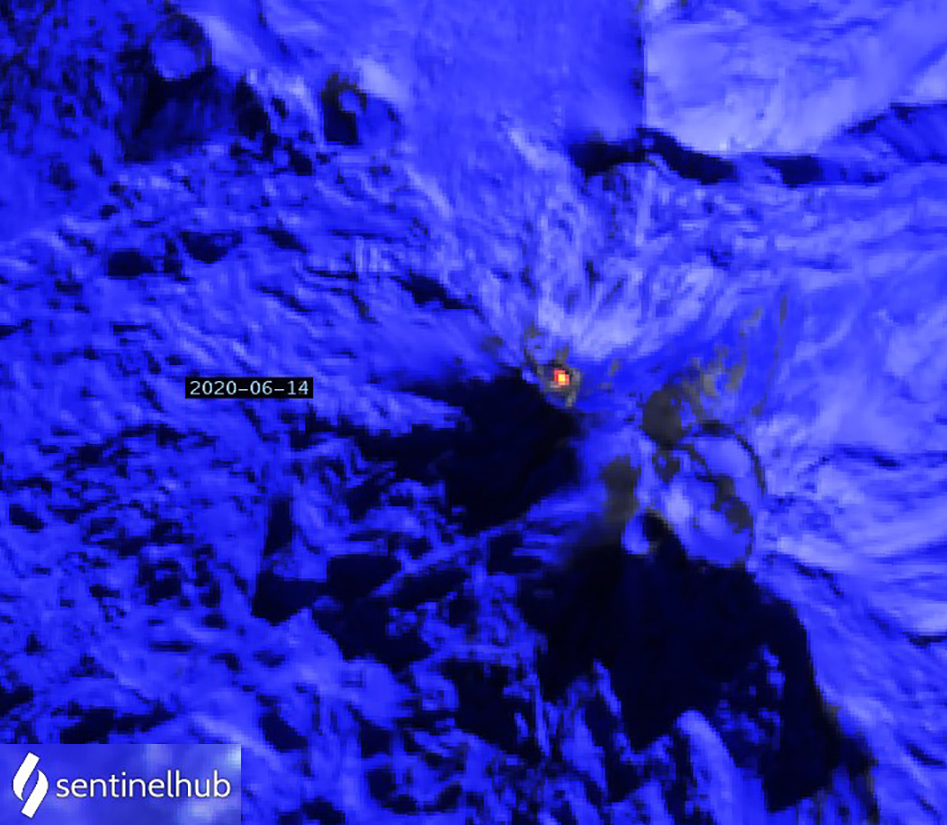Report on Nevados de Chillan (Chile) — July 2020
Bulletin of the Global Volcanism Network, vol. 45, no. 7 (July 2020)
Managing Editor: Edward Venzke.
Edited by A. Elizabeth Crafford.
Nevados de Chillan (Chile) Explosions and pyroclastic flows continue; new dome emerges from Nicanor crater in June 2020
Please cite this report as:
Global Volcanism Program, 2020. Report on Nevados de Chillan (Chile) (Crafford, A.E., and Venzke, E., eds.). Bulletin of the Global Volcanism Network, 45:7. Smithsonian Institution. https://doi.org/10.5479/si.GVP.BGVN202007-357070
Nevados de Chillan
Chile
36.868°S, 71.378°W; summit elev. 3180 m
All times are local (unless otherwise noted)
Nevados de Chillán is a complex of late-Pleistocene to Holocene stratovolcanoes in the Chilean Central Andes. An eruption started with a phreatic explosion and ash emission on 8 January 2016 from a new crater (Nicanor) on the E flank of the Nuevo crater, itself on the NW flank of the large Volcán Viejo stratovolcano. Strombolian explosions and ash emissions continued throughout 2016 and 2017; a lava dome within the Nicanor crater was confirmed in early January 2018. Explosions and pyroclastic flows continued during 2018 and 2019, with several lava flows appearing in late 2019. This report covers continuing activity from January-June 2020 when ongoing explosive events produced ash plumes, pyroclastic flows, and the growth of new dome inside the crater. Information for this report is provided primarily by Chile's Servicio Nacional de Geología y Minería (SERNAGEOMIN)-Observatorio Volcanológico de Los Andes del Sur (OVDAS), and by the Buenos Aires Volcanic Ash Advisory Center (VAAC).
Explosions with ash plumes rising up to three kilometers above the summit area were intermittent from late January through early June 2020. Some of the larger explosions produced pyroclastic flows that traveled down multiple flanks. Thermal anomalies within the Nicanor crater were recorded in satellite data several times each month from February through June. A reduction in overall activity led SERNAGEOMIN to lower the Alert Level from Orange to Yellow (on a 4-level, Green-Yellow-Orange-Red scale) during the first week of March, although tens of explosions with ash plumes were still recorded during March and April. Explosive activity diminished in early June and SERNAGEOMIN reported the growth of a new dome inside the Nicanor crater. By the end of June, a new flow had extended about 100 m down the N flank. Thermal activity recorded by the MIROVA project showed a drop in thermal energy in mid-December 2019 after the lava flows of September-November stopped advancing. A decrease in activity in January and February 2020 was followed by an increase in thermal and explosive activity in March and April. Renewed thermal activity from the growth of a new dome inside the Nicanor crater was recorded beginning in mid-June (figure 52).
Weak gas emissions were reported daily during January 2020 until a series of explosions began on the 21st. The first explosion rose 100 m above the active crater; the following day, the highest explosion rose 1.6 km above the crater. The Buenos Aires VAAC reported pulse emissions visible in satellite imagery on 21 and 24 January that rose to 3.9-4.3 km altitude and drifted SE and NE, respectively. Intermittent explosions continued through 26 January. Incandescent ejecta was observed during the night of 28-29 January. The VAAC reported an isolated emission on 29 January that rose to 5.2 km altitude and drifted E. A larger explosion on 30 January produced an ash plume that SERNAGEOMIN reported at 3.4 km above the crater (figure 53). It produced pyroclastic flows that traveled down ravines on the NNE and SE flanks. The Washington VAAC reported on behalf of the Buenos Aires VAAC that an emission was observed in satellite imagery on 30 January that rose to 4.9 km altitude and was moving rapidly E, reaching 15 km from the summit at midday. The altitude of the ash plume was revised two hours later to 7.3 km, drifting NNE and rapidly dissipating. Satellite images identified two areas of thermal anomalies within the Nicanor crater that day. One was the same emission center (CE4) identified in November 2019, and the second was a new emission center (CE5) located 60 m NW.
When the weather permitted, low-altitude mostly white degassing was seen during February 2020, often with traces of fine-grained particulate material. Incandescence at the crater was observed overnight during 4-5 February. The Buenos Aires VAAC reported an emission on 14 February visible in the webcam. The next day, an emission was visible in satellite imagery at 3.9 km altitude that drifted E. Episodes of pulsating white and gray plumes were first observed by SERNAGEOMIN beginning on 18 February and continued through 25 February (figure 54). The Buenos Aires VAAC reported pulses of ash emissions moving SE on 18 February at 4.3 km altitude. Ash drifted E the next day at 3.9 km altitude and a faint plume was briefly observed on 20 February drifting N at 3.7 km altitude before dissipating. Sporadic pulses of ash moved SE from the volcano on 22 February at 4.3 km altitude, briefly observed in satellite imagery before dissipating. Thermal anomalies were visible from the Nicanor crater in Sentinel-2 satellite imagery on 23 and 28 February.
Only low-altitude degassing of mostly steam was reported for the first half of March 2020. When SERNAGEOMIN lowered the Alert Level from Orange to Yellow on 5 March, they reduced the affected area from 5 km NE and 3 km SW of the crater to a radius of 2 km around the active crater. Thermal anomalies were recorded at the Nicanor crater in Sentinel-2 imagery on 4, 9, 11, 16, and 19 March (figure 55). A new series of explosions began on 19 March; 44 events were recorded during the second half of the month (figure 56). Webcams captured multiple explosions with dense ash plumes; on 25 and 30 March the plumes rose more than 2 km above the crater. Fine-grained ashfall occurred in Las Trancas (10 km SW) on 25 March. Pyroclastic flows on 25 and 30 March traveled 300 m NE, SE, and SW from the crater. Incandescence was observed at night multiple times after 20 March. The Buenos Aires VAAC reported several discrete pulses of ash that rose to 4.3 km altitude and drifted SE on 20 and 21 March, SW on 25 March, and SE on 29 and 30 March. Another ash emission rose to 5.5 km altitude later on 30 March and drifted SE.
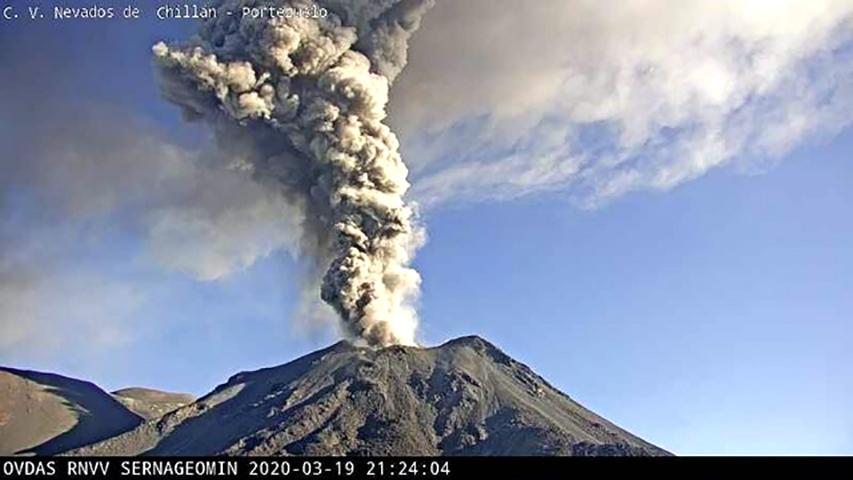 |
Figure 56. Forty-four explosive events were recorded at Nevados de Chillan during the second half of March 2020 including on 19 March. Courtesy of SERNAGEOMIN webcams and chillanonlinenoticia. |
In their semi-monthly reports for April 2020, SERNAGEOMIN reported 94 explosive events during the first half of the month and 49 during the second half; many produced dense ash plumes. The Buenos Aires VAAC reported frequent intermittent ash emissions during 1-13 April reaching altitudes of 3.7-4.3 km (figure 57). They reported the plume on 8 April visible in satellite imagery at 7.3 km altitude drifting SE. An emission on 13 April was also visible in satellite imagery at 6.1 km altitude drifting NE.
During the second half of April 2020, SERNAGEOMIN reported that only one plume exceeded 2 km in height; on 21 April, it rose to 2.4 km above the crater (figure 58). The Buenos Aires VAAC reported isolated pulses of ash on 18, 26, 28, and 30 April. During the second half of April SERNAGEOMIN also reported that a pyroclastic flow traveled about 1,200 m from the crater rim down the SE flank. The ash from the pyroclastic flow drifted SE and S as far as 3.5 km. Satellite images showed continued activity from multiple emission centers around the crater. Pronounced scarps were noted on the internal walls of the crater, attributed to the deepening of the crater from explosive activity.
Intermittent explosive activity continued during May 2020. The plumes contained abundant particulate material and were accompanied by periodic pyroclastic flows and incandescent ejecta around the active crater, especially visible at night. The Buenos Aires VAAC reported several sporadic weak ash emissions during the first week of May that rose to 3.7-5.2 km altitude and drifted NE. SERNAGEOMIN reported that only one explosion produced an ash emission that rose more than two km above the crater during the first two weeks of the month; on 6 May it rose to 2.5 km above the crater and drifted NE. They also observed pyroclastic flows on the E and SE flanks that day. Additional pyroclastic flows traveled 450 m down the S flank during the first half of the month, and similar deposits were observed to the N and NE. Satellite observations showed various emission points along the NW-trending lineament at the summit and multiple erosion scarps. Major erosion was noted at the NE rim of the crater along with an increase in degassing around the rim.
During the second half of May 2020 most of the ash plumes rose less than 2 km above the crater; a plume from one explosion on 22 May rose 2.2 km above the crater; the Buenos Aires VAAC reported the plume at 5.5 km altitude drifting NW (figure 59). Continuing pyroclastic emissions deposited material as far as 1.5 km from the crater rim on the NNW flank. There were also multiple pyroclastic deposits up to 500 m from the crater directed N and NE during the period. SERNAGEOMIN reported an increase in steam degassing between Nuevo-Nicanor and Nicanor-Arrau craters.
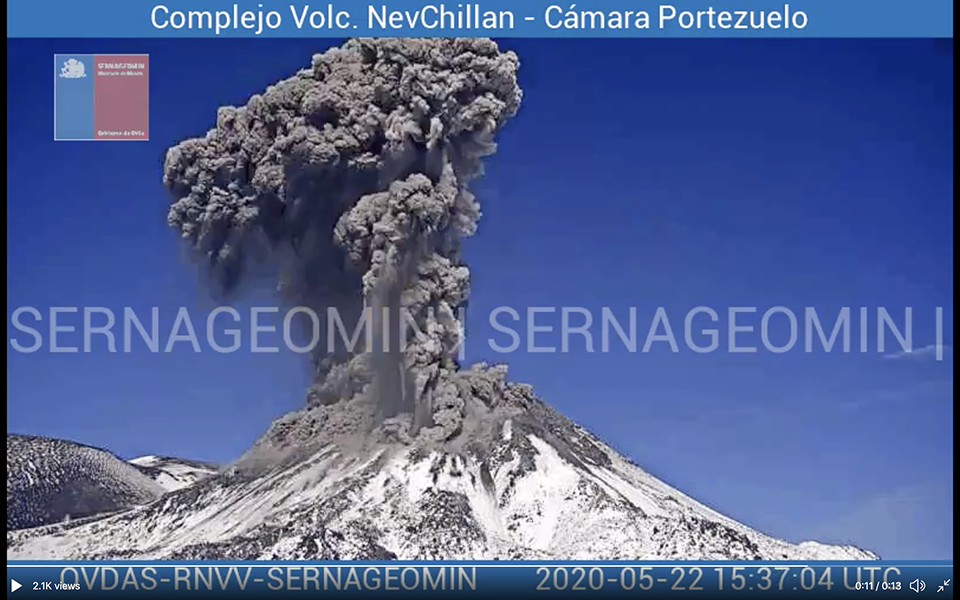 |
Figure 59. Explosions produced dense ash plumes and pyroclastic flows at Nevados de Chillan multiple times during May 2020 including on 22 May. Courtesy of SERNAGEOMIN. |
Webcam images during the first two weeks of June 2020 indicated multiple incandescent explosions. On 3 and 4 June plumes from explosions reached heights of over 1.25 km above the crater; the Buenos Aires VAAC reported them drifting NW at 3.9 km altitude. Incandescent ejecta on 6 June rose 760 m above the vent and drifted NE. In addition, pyroclastic flows were distributed on the N, NW, E and SE flanks. Significant daytime and nighttime incandescence was reported on 6, 9, and 10 June (figure 60). The VAAC reported emission pulses on 6 and 9 June drifting E and SE at 4.3 km altitude.
SERNAGEOMIN reported that beginning on the afternoon of 9 June 2020 a tremor-type seismic signal was first recorded, associated with continuous emission of gas and dark gray ash that drifted SE (figure 61). A little over an hour later another tremor signal began that lasted for about four hours, followed by smaller discrete explosions. A hybrid-type earthquake in the early morning of 10 June was followed by a series of explosions that ejected gas and particulate matter from the active crater. The vent where the emissions occurred was located within the Nicanor crater close to the Arrau crater; it had been degassing since 30 May.
After the explosions on the afternoon of 9 June, a number of other nearby vents became active. In particular, the vent located between the Nuevo and Nicanor craters began emitting material for the first time during this eruptive cycle. The explosion also generated pyroclastic flows that traveled less than 50 m in multiple directions away from the vent. Abundant incandescent material was reported during the explosion early on 10 June. Deformation measurements showed inflation over the previous 12 days.
SERNAGEOMIN identified a surface feature in satellite imagery on 11 June 2020 that they interpreted as a new effusive lava dome. It was elliptical with dimensions of about 85 x 120 m. In addition to a thermal anomaly attributed to the dome, they noted three other thermal anomalies between the Nuevo, Arrau, and Nicanor craters. They reported that within four days the base of the active crater was filled with effusive material. Seismometers recorded tremor activity after 11 June that was interpreted as associated with lava effusion. Incandescent emissions were visible at night around the active crater. Sentinel-2 satellite imagery recorded a bright thermal anomaly inside the Nicanor crater on 14 June (figure 62).
A special report from SERNAGEOMIN on 24 June 2020 noted that vertical inflation had increased during the previous few weeks. After 20 June the inflation rate reached 2.49 cm/month, which was considered high. The accumulated inflation measured since July 2019 was 22.5 cm. Satellite imagery continued to show the growth of the dome, and SERNAGEOMIN scientists estimated that it reached the E edge of the Nicanor crater on 23 June. Based on these images, they estimated an eruptive rate of 0.1-0.3 m3/s, about two orders of magnitude faster than the Gil-Cruz dome that emerged between December 2018 and early 2019.
Webcams revealed continued low-level explosive activity and incandescence visible both during the day and at night. By the end of June, webcams recorded a lava flow that extended 94 m down the N flank from the Nicanor crater and continued to advance. Small explosions with abundant pyroclastic debris produced recurring incandescence at night. Satellite infrared imagery indicated thermal radiance from effusive material that covered an area of 37,000 m2, largely filling the crater. DEM analysis suggested that the size of the crater had tripled in volume since December 2019 due largely to erosion from explosive activity since May 2020. Sentinel-2 satellite imagery showed a bright thermal anomaly inside the crater on 27 June.
Geological Summary. The compound volcano of Nevados de Chillán is one of the most active of the Central Andes. Three late-Pleistocene to Holocene stratovolcanoes were constructed along a NNW-SSE line within three nested Pleistocene calderas, which produced ignimbrite sheets extending more than 100 km into the Central Depression of Chile. The dominantly andesitic Cerro Blanco (Volcán Nevado) stratovolcano is located at the NW end of the massif. Volcán Viejo (Volcán Chillán), which was the main active vent during the 17th-19th centuries, occupies the SE end. The Volcán Nuevo lava-dome complex formed during 1906-1945 on the NW flank of Viejo. The Volcán Arrau dome complex was then constructed on the SE side of Volcán Nuevo between 1973 and 1986, and eventually exceeded its height. Smaller domes or cones are present in the 5-km valley between the two major edifices.
Information Contacts: Servicio Nacional de Geología y Minería (SERNAGEOMIN), Observatorio Volcanológico de Los Andes del Sur (OVDAS), Avda Sta María No. 0104, Santiago, Chile (URL: http://www.sernageomin.cl/, https://twitter.com/Sernageomin); MIROVA (Middle InfraRed Observation of Volcanic Activity), a collaborative project between the Universities of Turin and Florence (Italy) supported by the Centre for Volcanic Risk of the Italian Civil Protection Department (URL: http://www.mirovaweb.it/); Buenos Aires Volcanic Ash Advisory Center (VAAC), Servicio Meteorológico Nacional-Fuerza Aérea Argentina, 25 de mayo 658, Buenos Aires, Argentina (URL: http://www.smn.gov.ar/vaac/buenosaires/inicio.php); Sentinel Hub Playground (URL: https://www.sentinel-hub.com/explore/sentinel-playground); #EmergenciasÑuble (URL: https://twitter.com/urgenciasnuble/status/1222943399185207296); T13, Channel 13 Press Department (URL: https://twitter.com/T13/status/1222951071443771394); Chillanonlinenoticia (URL: https://twitter.com/ChillanOnline/status/1240754211932995595); Noticias Valpo Express (URL: https://twitter.com/NoticiasValpoEx/status/1252715033131388928); Sismo Alerta Mexicana (URL: https://twitter.com/Sismoalertamex/status/1269351579095691265); Volcanology Chile (URL: https://twitter.com/volcanologiachl/status/1270548008191643651).


